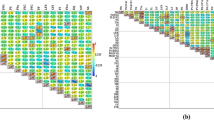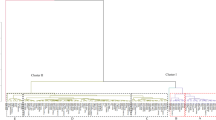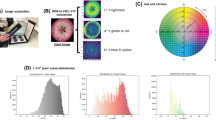Abstract
This study investigated potential mislabeling within 23 fig cultivars from northern Morocco by integrating morphometric and biochemical markers through multivariate analysis. The aim was to assess cultivar identification accuracy and explore efficient germplasm management strategies. Canonical correlation analysis (CCA) revealed a statistically significant and substantial correlation between the morphometric and biochemical datasets (Wilk’s λ = 0.004, F [84, 179.49] = 3.18, p < 0.0001), a key step unveiling the interconnected nature of these traits and their combined potential for accurate cultivar discrimination. The interplay of datasets demonstrated that dark-colored figs exhibited higher levels of total phenols, anthocyanin, and radical 2,2-diphenyl-1-picrylhydrazyl (DPPH) radical scavenging activity, with the ‘Ghoudan’ cultivar consistently showing the highest concentrations. However, total phenol content did not correlate significantly with fruit color parameters, suggesting a more complex relationship. Proanthocyanidin levels were minimal across cultivars, and the ABTS assay consistently indicated higher antioxidant activity compared to DPPH. Total soluble sugars exhibited minimal variation among fruits. Leveraging CCA results, hierarchical clustering identified potential homonymy instances within ‘Ghoudan,’ ‘El Quoti Lbied,’ and ‘Nabout’ cultivars, where fruit weight, width, skin color coordinates, total phenols, flavonoids, and DPPH radical scavenging activity emerged as influential factors for discerning mislabeling. These findings underscore the efficacy of integrating morphometric and biochemical characterization for accurate fig cultivar identification and mislabeling detection within germplasm collections. The strong CCA correlation emphasizes this approach’s potential as a preliminary screening tool for large germplasm collections. By efficiently identifying potential mislabeling cases, resources can be directed towards molecular confirmation, ensuring the integrity and effective management of valuable fig genetic resources.




Similar content being viewed by others
Data availability
All data supporting the findings of this study are fully presented within the manuscript.
References
achinello JC, Hoffmann A, Nachtgal JC (2005) Propagação de plantas frutíferas. Embrapa Informações Tecnológicas, Brasília (221 p)
Achtak H, Ater M, Oukabli A, Santoni S, Kjellberg F, Khadari B (2010) Traditional agroecosystems as conservatories and incubators of cultivated plant varietal diversity: the case of fig (Ficus carica L.) in Morocco. BMC Plant Biol 10(1):28. https://doi.org/10.1186/1471-2229-10-28
Badgujar S, -Patel V, -Bandivdekar A, -Mahajan R (2014) Traditional uses. phytochemistry and pharmacology of Ficus carica: a review. Pharm Biol 52(11):1487–1503. https://doi.org/10.3109/13880209.2014.892515
Almajali DA, Abdel-Ghani AH, Migdadi H (2012) Evaluation of genetic diversity among Jordanian fig germplasm accessions by morphological traits and ISSR markers. Scientia Horticulturae Nov 12;147:8-19.
Barreira JC, Ferreira IC, Oliveira MBP, Pereira JA (2008) Antioxidant activities of the extracts from chestnut flower, leaf, skins and fruit. Food Chem 107(3):1106–1113. https://doi.org/10.1016/j.foodchem.2007.09.030
Brand-Williams W, Cuvelier ME, Berset CLWT (1995) Use of a free radical method to evaluate antioxidant activity. LWT Food Sci Technol 28(1):25–30. https://doi.org/10.1016/S0023-6438(95)80008-5
Çalişkan O, Polat AA (2008) Fruit characteristics of fig cultivars and genotypes grown in Turkey. Sci Hortic 115(4):360–367. https://doi.org/10.1016/j.scienta.2007.10.017
Çalişkan O, Polat AA (2012) Morphological diversity among fig (Ficus carica L.) accessions sampled from the Eastern Mediterranean Region of Turkey. Turk J Agric For 36(2):179–193. https://doi.org/10.3906/tar-1102-33
Crisosto H, Ferguson L, Bremer V, Stover E, Colelli G (2011) Fig (Ficus carica L.). In: Postharvest biology and technology of tropical and subtropical fruits. Woodhead Publishing, pp 134–160e https://doi.org/10.1533/9780857092885.134
Cheng GW, Breen PJ (1991) Activity of phenylalanine ammonia-lyase (PAL) and concentrations of anthocyanins and phenolics in develo** strawberry fruit. J Am Soc Hortic Sci. 1;116(5):865-9.
Dubois M, GILLe SKA, Hamilton JK, Rebers PT, Smith F (1956) Colorimetric method for determination of sugars and related substances. Anal Chem 28(3):350–356
Ercisli S, Tosun M, Karlidag H, Dzubur A, Hadziabulic S, Aliman Y (2012) Color and antioxidant characteristics of some fresh fig (Ficus carica L.) genotypes from Northeastern Turkey. Plant Foods Hum Nutr 67(3):271–276. https://doi.org/10.1007/s11130-012-0292-2
Ersoy N, Gözlekçi S, Kaynak L (2007) Changes in sugar contents of fig fruit (Ficus carica l. Cv. Bursa Siyahı) during development. Süleyman Demirel Üniv Ziraat Fak Derg 2(2):22–26
Essid A, Aljane F, Ferchichi A (2017) Morphological characterization and pollen evaluation of some Tunisian ex situ planted caprifig (Ficus carica L.) ecotypes. S Afr J Bot 111:134–143. https://doi.org/10.1016/j.sajb.2017.03.001
FAOSTAT database (accessed April 20, 2024). http://www.fao.org/faostat/en/#data
Flaishman MA, Rodov V, Stover E (2008) The fig: botany, horticulture, and breeding. Hortic Rev Then N Y 34:113. https://doi.org/10.1002/9780470380147.ch2
Harzallah A, Bhouri AM, Amri Z, Soltana H, Hammami M (2016) Phytochemical content and antioxidant activity of different fruit parts juices of three figs (Ficus carica L.) varieties grown in Tunisia. Ind Crops Prod 83:255–267. https://doi.org/10.1016/j.indcrop.2015.12.043
Hill T, Lewicki P (2007) Statistics methods and applications. Statsoft, Tulsa
Hirst K (1996) Fig trees and archaeology. The history of the domestication of Fig trees. About. com Archaeology. http://archaeology.about.com/od/domestications/a/fig_trees.htm
Hmimsa Y, Aumeeruddy-Thomas Y, Ater M (2017) Une forme spontanée de figuier (Ficus carica L.), le nābūt. Diversité de nomenclature, d’usage et de pratiques locales au Nord du Maroc. Revue D’ethnoécologie. https://doi.org/10.4000/ethnoecologie.3186
Hoogendijk M, Williams DE (2002) Characterizing the genetic diversity of home garden crops: some examples from the Americas. Home gardens and in situ conservation of plant genetic resources in farming systems. International Plant Genetic Resources Institute, Witzenhausen, pp 34–40
Hssaini L, Charafi J, Hanine H, Ennahli S, Mekaoui A, Mamouni A, Razouk R (2019) Comparative analysis and physio-biochemical screening of an ex-situ fig (Ficus carica L.) collection. Hortic Environ Biotechnol 60(5):671–683
Itle RA, Kabelka EA (2009) Correlation between L* a* b* color space values and carotenoid content in pumpkins and squash (Cucurbita spp.). HortScience 44(3):633–637. https://doi.org/10.21273/HORTSCI.44.3.633
IPGRI and CIHEAM (2003) Descriptors for Figs. International Plant Genetic Resources Institute (IPGRI), Rome, Italy, and the International Centre for Advanced Mediterranean Agronomic Studies (CIHEAM), Paris, France
Khadari B (2010) Ex situ management of fig (Ficus carica L.) genetic resources: towards the establishment of the Mediterranean reference collection. In: XXVIII International Horticultural Congress on Science and Horticulture for People (IHC2010): International Symposium on the 940, pp 67–74 https://doi.org/10.17660/ActaHortic.2012.940.7
Khadhraoui M, Bagues M, Artés F, Ferchichi A (2019) Phytochemical content, antioxidant potential, and fatty acid composition of dried Tunisian fig (Ficus carica L.) cultivars. J Appl Bot Food Qual 92:143–150
Khadivi A, Anjam R, Anjam K (2018) Morphological and pomological characterization of edible fig (Ficus carica L.) to select the superior trees. Sci Hortic 238:66–74. https://doi.org/10.1016/j.scienta.2018.04.031
Koskitalo LN, Ormrod DP (1972) Effects of sub-optimal ripening temperatures on the color quality and pigment composition of tomato fruit. J Food Science 37(1):56–59. https://doi.org/10.1111/j.1365-2621.1972.tb03384.x
Kuś PM, Congiu F, Teper D, Sroka Z, Jerković I, Tuberoso CIG (2014) Antioxidant activity, color characteristics, Total phenol content and general HPLC fingerprints of six Polish unifloral honey types. LWT Food Sci Technol 55(1):124–130. https://doi.org/10.1016/j.lwt.2013.09.016
Mahdavian M, Lessani H, Kuhi M, Zare H, Krami M, Tabatabei Z (2006) Assessment of genetic diversity among different fig (Ficus carica L.) collection from Iran. Acta Hortic 760:29–37. https://doi.org/10.21273/HORTSCI11306-16
Michailides TJ, Morgan DP (1998) Spread of endosepsis in Calimyrna fig orchards. Phytopathology 88(7):637–647. https://doi.org/10.1094/PHYTO.1998.88.7.637
Pereira C, López Corrales M, Martín A, Villalobos MDC, Córdoba MDG, Serradilla MJ (2017) Physicochemical and nutritional characterization of brebas for fresh consumption from nine fig varieties (Ficus carica L.) grown in Extremadura (Spain). J Food Quality. https://doi.org/10.1155/2017/6302109
Perez-Sanchez R, Morales-Corts MR, Gomez-Sanchez MA (2016) Agromorphological diversity of traditional fig cultivars grown in centralwestern Spain. Genetika 48(2):533–546. https://doi.org/10.2298/GENSR1602533P
Porter LJ, Hrstich LN, Chan BG (1985) The conversion of procyanidins and prodelphinidins to cyanidin and delphinidin. Phytochemistry 25(1):223–230. https://doi.org/10.1016/S0031-9422(00)94533-3
Re R, Pellegrini N, Proteggente A, Pannala A, Yang M, Rice-Evans C (1999) Antioxidant activity applying an improved ABTS radical cation decolorization assay. Free Radic Biol Med 26(9-10):1231–1237. https://doi.org/10.1016/S0891-5849(98)00315-3
Rival L, Mckey D (2008) Domestication and diversity in manioc (Manihot esculenta Crantz ssp. esculenta, Euphorbiaceae). Curr Anthropol 49(6):1119–1128. https://doi.org/10.1086/593119
Sandhu AK, Islam M, Edirisinghe I, Burton-Freeman B (2023) Phytochemical composition and health benefits of figs (fresh and dried): a review of literature from 2000 to 2022. Nutrients 15(11):2623
Sedaghat S, Rahemi M (2018) Enzyme activity regarding sugar and organic acid changes during developmental stages in rainfed fig (Ficus carica L. cv Sabz). Int J Fruit Sci 18(1):14–28. https://doi.org/10.1080/15538362.2017.1367984
Solomon A, Golubowicz S, Yablowicz Z, Grossman S, Bergman M, Gottlieb HE, Altman A, Kerem Z, Flaishman MA (2006) Antioxidant activities and anthocyanin content of fresh fruits of common fig (Ficus carica L.). J Agric Food Chem 54(20):7717–7723. https://doi.org/10.1021/jf060497h
Tamboli BD, Sawale DD, Jagtap PB, Nimbalkar RU, Teke SR (2015) Effect of micronutrients on yield and fruit quality of fig on Inceptisol. Indian J Hort 72(3):419–422. https://doi.org/10.5958/0974-0112.2015.00061.4
Veberic R, Mikulic-Petkovsek M (2015) Phytochemical composition of common fig (Ficus carica L.) cultivars. Academic Press, London, p 235 https://doi.org/10.1016/B978-0-12-408117-8.00011-8
Vinson JA, Zubik L, Bose P, Samman N, Proch J (2005) Dried fruits: excellent in vitro and in vivo antioxidants. J Am Coll Nutr 24(1):44–50. https://doi.org/10.1080/07315724.2005.10719442
Viuda-Martos M, Barber X, Perez-Alvarez JA, Fernandez-Lopez J (2015) Assessment of chemical, physico-chemical, techno-functional and antioxidant properties of fig (Ficuscarica L.) powder co-products. Ind Crops Prod 69:472–479. https://doi.org/10.1016/j.indcrop.2015.03.005
Waterhouse AL (2002) Determination of total phenolics. Curr Protoc Food Anal Chem 6(1):I1–1. https://doi.org/10.1002/0471142913.fai0101s06
Wojdyło A, Nowicka P, Carbonell-Barrachina ÁA, Hernández F (2016) Phenolic compounds, antioxidant and antidiabetic activity of different cultivars of Ficus carica L. fruits. J Funct Foods 25:421–432. https://doi.org/10.1016/j.jff.2016.06.015
Further reading
Abdel-Ghani AH, Migdadi H (2012) Evaluation of genetic diversity among Jordanian fig germplasm accessions by morphological traits and ISSR markers. Sci Hortic 147:8–19. https://doi.org/10.1016/j.scienta.2012.08.029
Chalak L, Chehade A, Elbitar A, Achtak H, Santoni S, Essalouhy L, Khadari B (2022) Assessment of the genetic diversity of fig trees growing in Lebanon indicates a continuum of genetic diversity between spontaneous and cultivated forms. InXXXI International Horticultural Congress (IHC2022): International Symposium on Conservation and Sustainable Use of 1384 (pp. 233-238).
L’africain L (1896) Description de l’Afrique: tierce partie du monde. Altair
Minguez-Mosquera I, Rejano-Navarro M, Gandul-Rojas L, Sanchezgomez B, Garrido-Fernandez AH (1991) Color-pigment correlation in virgin olive oil. J Am Oil Chem Soc 68(5):332–336. https://doi.org/10.1007/BF02657688
Acknowledgements
We would like to thank the local farmers who provided the fig cultivars for this study. It is important to acknowledge that these cultivars might be of polyclonal origin due to traditional propagation methods.
Funding
This research did not receive any specific grant from funding agencies in the public, commercial, or not-for-profit sectors
Author information
Authors and Affiliations
Corresponding author
Ethics declarations
Conflict of interest
L. Hssaini, R. Razouk and N. Haoudi declare that they have no competing interests.
Additional information
Publisher’s Note
Springer Nature remains neutral with regard to jurisdictional claims in published maps and institutional affiliations.
Rights and permissions
Springer Nature or its licensor (e.g. a society or other partner) holds exclusive rights to this article under a publishing agreement with the author(s) or other rightsholder(s); author self-archiving of the accepted manuscript version of this article is solely governed by the terms of such publishing agreement and applicable law.
About this article
Cite this article
Hssaini, L., Razouk, R. & Haoudi, N. Canonical Correlation Model for Understanding Fig (Ficus carica L.) Mislabeling Using Biochemical and Morphometric Markers. Applied Fruit Science (2024). https://doi.org/10.1007/s10341-024-01121-9
Received:
Accepted:
Published:
DOI: https://doi.org/10.1007/s10341-024-01121-9




